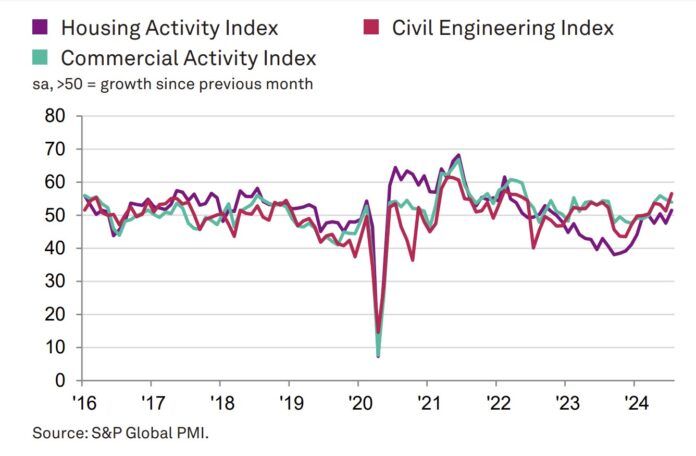Growth accelerated in the UK construction sector as the second half of the year got underway, with July 2024 seeing much faster increases in both activity and new orders during the month.
In turn, firms ramped up purchasing activity and raised staffing levels for the third month running. Higher demand for inputs imparted some pressure on supply chains, and input costs increased at a faster pace.
This was evident in the latest S&P Global UK Construction Purchasing Managers’ Index (PMI), which rose sharply to 55.3 in July from 52.2 in June. The reading signalled a marked monthly expansion in total activity in the construction sector, extending the current sequence of growth to five months. Moreover, the rate of expansion was the fastest since May 2022.
Breakdown
All three categories of construction saw activity increase in July as work on housing projects returned to growth. Commercial activity increased solidly, but the fastest expansion was seen in civil engineering activity, where the rate of growth quickened to the sharpest in almost two-and-a-half years.
According to respondents of the PMI survey, success in securing new orders was the main factor leading to a rise in construction activity at the start of the third quarter. New business expanded for the sixth month running, and at a marked pace that was the strongest since April 2022. Alongside a general improvement in market demand, there were also reports that customer confidence had strengthened, making them more willing to release previously paused projects.
Rising workloads led construction firms to expand both their purchasing activity and employment more quickly in July.
Staffing levels were up for the third consecutive month, and at a solid pace that was the fastest for a year.
Rising demand
Meanwhile, a strong rise in purchasing activity was the most pronounced in almost two years.
Increased demand for inputs put some pressure on suppliers in July, resulting in broadly unchanged lead times during the month. This ended a 16-month sequence of improving vendor performance. Panellists also reported issues with manufacturing and transportation.
However, some respondents indicated that suppliers had sufficient stocks to keep on top of orders.
The rate of input cost inflation meanwhile showed signs of picking up as suppliers raised prices in line with stronger demand. The solid increase in input costs was the joint fastest in 14 months, equal with that seen in January. But the rate of inflation was still much weaker than the series average.
Subcontractors
Subcontractor usage rose for the fourth month running, and at a solid pace. Although sub-contractor availability continued to increase markedly, the latest rise was the least pronounced since June 2023. Moreover, the rates charged by subcontractors increased modestly again.
Outlook
Construction firms remained strongly optimistic that activity will expand over the coming year, although sentiment dipped to a three-month low in July. Improving client confidence is predicted to help lead to growth of new orders and subsequently activity.
New product development is also set to support activity, with close to 53% of respondents predicted a rise in activity over the next 12 months.




